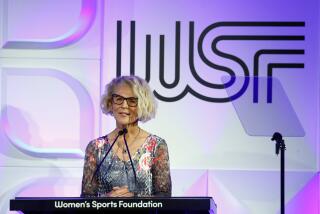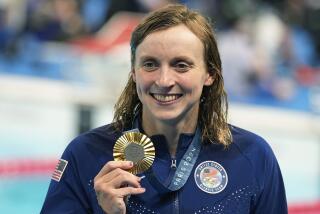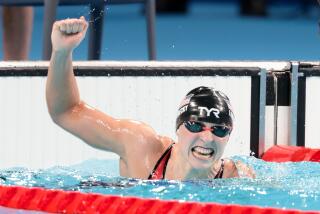Riding the Wave of the Future : Swimming: Kristine Quance has surfaced as an extraordinary young talent.
- Share via
She might be a bit young to be a debutante, but Kristine Quance was a splashing success in her coming-out party in the U. S. Swimming Senior Short Course championships in March.
At age 14, Northridge’s Quance posted three top-eight finishes, set a national age-group record in the 200-yard breaststroke and broke two other Southern California age-group records.
Few young women have shown such promise coming out of the water since Aphrodite emerged from the ocean foam.
Quance, who turned 15 on April 1, swam 2 minutes 15.61 seconds in the 200 breaststroke preliminaries to better the 13-14-year-old national record that Shannon Orcutt set in 1981. Quance broke Southern California records in the 200 and 400 individual medleys. She finished fifth in both IMs and sixth in the breaststroke.
For comparison, four 14-year-olds made the finals in the 1985 long-course nationals, and three, including Janet Evans, went on to compete in the 1988 Olympics. The fourth swam for the 1986 world championship team.
Quance showed the same sort of potential two weeks ago in the short-course championships in Nashville, Tenn.
“That’s good and bad,” said Jeff Dimond, the information services director for U. S. Swimming. “It could be a signal that we’ve got a great one on our hands . . . or it could be a signal that she’s a candidate for burnout.”
A crucial test will come this summer in the national long-course championships in Austin, Tex. Most top female collegians skip the short-course nationals, which are held immediately after the NCAA meet. The summer nationals have a stronger field and also serve as a tryout for the world championships.
“The way it’s planned is we want to see the young kids have a chance to break through and make a final when there aren’t any collegians,” Dimond said of the winter short-course format. “What we do is wait to see how they do at the next national meet.”
That meet should help determine whether Quance is the latest Orcutt, who had an undistinguished college career, or the next Tracy Caulkins, the only swimmer in the age group with faster times than Quance’s in the 200 and 400 IMs and a three-time Olympic gold medalist.
If Quance qualifies for the summer nationals, a virtual certainty, she will be competing in her third national meet and second long-course championships. She swam last summer in the long courses at USC and did not make the finals. But she did get her feet wet in high-level competition.
“I think I was kind of intimidated by all the people (at the USC meet), like Janet Evans and people I read (about) in magazines (who were) world record-holders,” Quance said. “I was not used to it, but when I went the second time (to Nashville), I knew what to expect. I wasn’t as nervous. . . . It just takes experience. I think I’ll do better at outdoors.”
Shy as a mermaid, the blond-haired Quance (5-foot-7, 130 pounds) is an arriviste on the national swimming scene.
“It all came pretty fast,” said Quance, who didn’t begin organized swimming until she was 10 1/2 and has only been training at competition level for less than two years. Her performance in Nashville was startling not only because of her national record but because of her consistency in several events.
Had Quance swum her best times from the short-course championships in the NCAAs the previous week, she would have finished 25th--as a team. Quance would have tied Arkansas and beaten such schools as Auburn, Texas A&M; and UC Santa Barbara.
Arkansas need not worry yet, but perhaps Birmingham and Calabasas highs should. Still a ninth-grader at Frost Junior High in Granada Hills, Quance will enter Granada Hills High next fall.
She said she will swim for Granada Hills in meets but will continue to train with the Valley Aquatic Swim Team and Coach Steve Reardon, who has helped her develop from beginner to world-class competitor.
Early in his protege’s career, Reardon converted Quance to an exaggerated style of breaststroking. Most breaststrokers look like turtles, barely poking their head and shoulders out of the water, but Quance bobs like a seal. Her long, limber legs propel the upper half of her torso above the surface in a style that few other top swimmers have adopted.
“It’s going to basically lift (a swimmer) up a hill and glide down a hill so a high-lift breaststroker can use fewer strokes,” Reardon said. “She was actually the guinea pig for developing the stroke. I just tried to work out a motion that seemed to take advantage of somebody who is flexible.
“It allows you to rest more during the first part of the race so that you’re stronger at the end of the race, which is why at the end of the 200, she’ll be coming in faster than someone who swims the low style.”
In the individual medley, the breaststroke portion--the third leg--is probably the most important leg. It also is probably the most difficult stroke for non-specialists to swim well.
“I started out as a breaststroker, but all my other strokes weren’t that good; my butterfly was really bad,” Quance said. Now, “my fly is pretty close to it, but my breaststroke is still my best stroke, but it’s not so much that my other strokes are bad.”
Reardon and Quance believe the 400 IM will be her best event, and she also might begin to swim the 200 butterfly more often. She is a better distance swimmer than sprinter, and her ability in several strokes is an obvious asset. However, the 400 IM also is one of Evans’ events, which means that as long as Evans competes, other swimmers are basically competing for one of two positions on Olympic teams.
Quance will participate in the Olympic Festival this summer in Minneapolis, and Dimond said she is a candidate to be invited this fall to the International Center for Aquatic Research in Colorado Springs, Colo., for physiological testing.
“I think that she’s in a good position because she has a chance to be there in ’92 or ‘96,” Reardon said. “If you looked at her two years ago and said, ‘Gee, will you be getting fifth in senior nationals?’ I don’t know if anybody would have said yes, so it’s hard to say what will happen two years from now.”
It remains to be seen whether Quance is just a flash in the pan or panning for Olympic gold. Any of the numerous physical, emotional and social changes that beset teen-age girls could wreak havoc on Quance’s career.
For now, she might not be a teen sensation like New Kids on the Block, but this new kid on the blocks certainly is a sensational teen.
More to Read
Go beyond the scoreboard
Get the latest on L.A.'s teams in the daily Sports Report newsletter.
You may occasionally receive promotional content from the Los Angeles Times.






